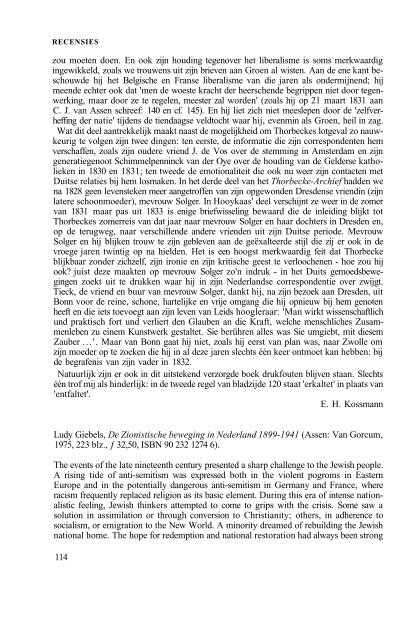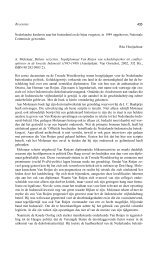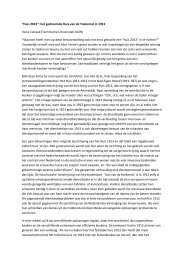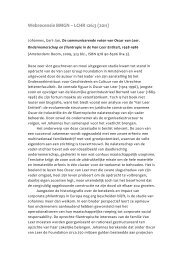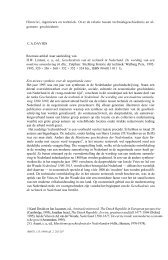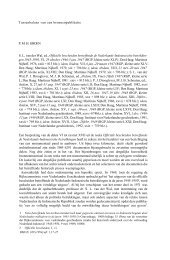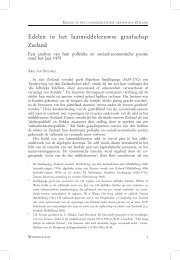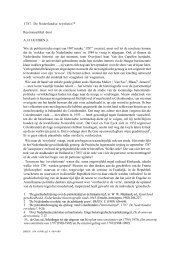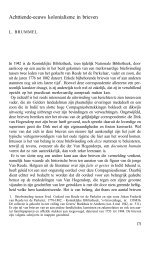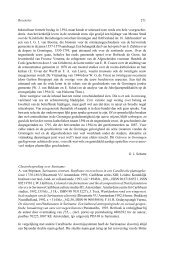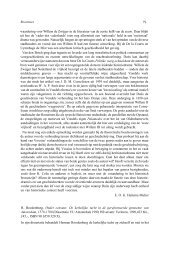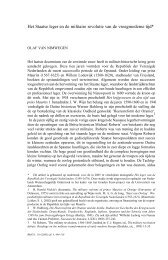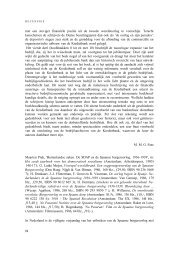De Zionistische beweging in Nederland 1899-1941
De Zionistische beweging in Nederland 1899-1941
De Zionistische beweging in Nederland 1899-1941
You also want an ePaper? Increase the reach of your titles
YUMPU automatically turns print PDFs into web optimized ePapers that Google loves.
RECENSIES<br />
zou moeten doen. En ook zijn houd<strong>in</strong>g tegenover het liberalisme is soms merkwaardig<br />
<strong>in</strong>gewikkeld, zoals we trouwens uit zijn brieven aan Groen al wisten. Aan de ene kant beschouwde<br />
hij het Belgische en Franse liberalisme van die jaren als ondermijnend; hij<br />
meende echter ook dat 'men de woeste kracht der heerschende begrippen niet door tegenwerk<strong>in</strong>g,<br />
maar door ze te regelen, meester zal worden' (zoals hij op 21 maart 1831 aan<br />
C. J. van Assen schreef: 140 en cf. 145). En hij liet zich niet meeslepen door de 'zelfverheff<strong>in</strong>g<br />
der natie' tijdens de tiendaagse veldtocht waar hij, evenm<strong>in</strong> als Groen, heil <strong>in</strong> zag.<br />
Wat dit deel aantrekkelijk maakt naast de mogelijkheid om Thorbeckes lotgeval zo nauwkeurig<br />
te volgen zijn twee d<strong>in</strong>gen: ten eerste, de <strong>in</strong>formatie die zijn correspondenten hem<br />
verschaffen, zoals zijn oudere vriend J. de Vos over de stemm<strong>in</strong>g <strong>in</strong> Amsterdam en zijn<br />
generatiegenoot Schimmelpenn<strong>in</strong>ck van der Oye over de houd<strong>in</strong>g van de Gelderse katholieken<br />
<strong>in</strong> 1830 en 1831; ten tweede de emotionaliteit die ook nu weer zijn contacten met<br />
Duitse relaties bij hem losmaken. In het derde deel van het Thorbecke-Archief hadden we<br />
na 1828 geen levensteken meer aangetroffen van zijn opgewonden Dresdense vriend<strong>in</strong> (zijn<br />
latere schoonmoeder), mevrouw Solger. In Hooykaas' deel verschijnt ze weer <strong>in</strong> de zomer<br />
van 1831 maar pas uit 1833 is enige briefwissel<strong>in</strong>g bewaard die de <strong>in</strong>leid<strong>in</strong>g blijkt tot<br />
Thorbeckes zomerreis van dat jaar naar mevrouw Solger en haar dochters <strong>in</strong> Dresden en,<br />
op de terugweg, naar verschillende andere vrienden uit zijn Duitse periode. Mevrouw<br />
Solger en hij blijken trouw te zijn gebleven aan de geëxalteerde stijl die zij er ook <strong>in</strong> de<br />
vroege jaren tw<strong>in</strong>tig op na hielden. Het is een hoogst merkwaardig feit dat Thorbecke<br />
blijkbaar zonder zichzelf, zijn ironie en zijn kritische geest te verloochenen - hoe zou hij<br />
ook? juist deze maakten op mevrouw Solger zo'n <strong>in</strong>druk - <strong>in</strong> het Duits gemoeds<strong>beweg<strong>in</strong>g</strong>en<br />
zoekt uit te drukken waar hij <strong>in</strong> zijn <strong>Nederland</strong>se correspondentie over zwijgt.<br />
Tieck, de vriend en buur van mevrouw Solger, dankt hij, na zijn bezoek aan Dresden, uit<br />
Bonn voor de re<strong>in</strong>e, schone, hartelijke en vrije omgang die hij opnieuw bij hem genoten<br />
heeft en die iets toevoegt aan zijn leven van Leids hoogleraar: 'Man wirkt wissenschaftlich<br />
und praktisch fort und verliert den Glauben an die Kraft, welche menschliches Zusammenleben<br />
zu e<strong>in</strong>em Kunstwerk gestaltet. Sie berühren alles was Sie umgiebt, mit diesem<br />
Zauber ...'. Maar van Bonn gaat hij niet, zoals hij eerst van plan was, naar Zwolle om<br />
zijn moeder op te zoeken die hij <strong>in</strong> al deze jaren slechts één keer ontmoet kan hebben: bij<br />
de begrafenis van zijn vader <strong>in</strong> 1832.<br />
Natuurlijk zijn er ook <strong>in</strong> dit uitstekend verzorgde boek drukfouten blijven staan. Slechts<br />
één trof mij als h<strong>in</strong>derlijk: <strong>in</strong> de tweede regel van bladzijde 120 staat 'erkaltet' <strong>in</strong> plaats van<br />
'entfaltet'.<br />
E. H. Kossmann<br />
Ludy Giebels, <strong>De</strong> <strong>Zionistische</strong> <strong>beweg<strong>in</strong>g</strong> <strong>in</strong> <strong>Nederland</strong> <strong>1899</strong>-<strong>1941</strong> (Assen: Van Gorcum,<br />
1975, 223 blz., ƒ 32,50, ISBN 90 232 1274 6).<br />
The events of the late n<strong>in</strong>eteenth century presented a sharp challenge to the Jewish people.<br />
A ris<strong>in</strong>g tide of anti-semitism was expressed both <strong>in</strong> the violent pogroms <strong>in</strong> Eastern<br />
Europe and <strong>in</strong> the potentially dangerous anti-semitism <strong>in</strong> Germany and France, where<br />
racism frequently replaced religion as its basic element. Dur<strong>in</strong>g this era of <strong>in</strong>tense nationalistic<br />
feel<strong>in</strong>g, Jewish th<strong>in</strong>kers attempted to come to grips with the crisis. Some saw a<br />
solution <strong>in</strong> assimilation or through conversion to Christianity; others, <strong>in</strong> adherence to<br />
socialism, or emigration to the New World. A m<strong>in</strong>ority dreamed of rebuild<strong>in</strong>g the Jewish<br />
national home. The hope for redemption and national restoration had always been strong<br />
114
RECENSIES<br />
<strong>in</strong> Jewish religious tradition and liturgy, and at this time, the idea of a national restoration<br />
through human effort began to supplant exclusive reliance on div<strong>in</strong>e <strong>in</strong>tervention. While<br />
there had always been a Jewish presence <strong>in</strong> the Holy Land, comprised of religious Jews, a<br />
group of young Russian Jews who wanted to work the land and make it their own set<br />
ashore on this largely depopulated and barren wasteland, <strong>in</strong> the 1880's, bef ore the establishment<br />
of what later became 'political Zionism'.<br />
The most famous confrontation between the assimilated Jew and the new anti-semitism<br />
occurred <strong>in</strong> Paris, where Theodor Herzl, corrrespondent for the Viennese Neue Freie<br />
Presse, witnessed the Dreyfus trial, which began <strong>in</strong> 1894 1 . Relat<strong>in</strong>g his personal reaction<br />
to the phenomenon of anti-semitism, Herzl wrote:<br />
I was <strong>in</strong>different to my Jewishness; let us say that it was beneath the level of my awareness.<br />
But just as anti-semitism forces the half-hearted, cowardly, and self-seek<strong>in</strong>g Jews<br />
<strong>in</strong>to the arms of Christianity, it powerfully forced my Jewishness to the surface 2 .<br />
In 1896, Herzl published <strong>De</strong>r Judenstaat, call<strong>in</strong>g for the establishment of a Jewish State,<br />
and <strong>in</strong> 1897, the First Zionist Congress was held <strong>in</strong> Basel, its program: to establish a 'home<br />
for the Jewish people secured by public law' 3 . The root of the term 'Zionism' is the word<br />
'Zion', a synonym for Jerusalem. The modern term, 'Zionism', first appeared <strong>in</strong> the late<br />
n<strong>in</strong>eteenth century, denot<strong>in</strong>g the movement whose goal was the return of the Jewish<br />
people to the Land of Israël 4 . Subsequently a world movement came <strong>in</strong>to be<strong>in</strong>g whose<br />
purpose was to advance and promote Jewish settlement of an area <strong>in</strong> the Ottoman Empire<br />
known as Palest<strong>in</strong>e. Herzl's <strong>in</strong>tention was that Zionism - <strong>in</strong> a real sense a prototype of a<br />
national liberation movement - would make it possible for Jews to build a new society and<br />
live honorably. At its <strong>in</strong>ception the Zionist movement did not emphasize freedom from<br />
imperialism or colonialism but from the degradations, material and moral, which European<br />
society had imposed on the Jews through the ages. These had their roots <strong>in</strong> the early<br />
formation of Christianity, where for the nascent Church<br />
anti-Judaism became a doctr<strong>in</strong>al necessity (from the time that it repudiated its first<br />
Judeo-Christian form); noth<strong>in</strong>g was more certa<strong>in</strong>: it could not show the truth of its<br />
faith without simultaneously denounc<strong>in</strong>g the error and bl<strong>in</strong>dness of Israël, the old<br />
Israël 5 .<br />
From this theological assumption, a process began whereby the debasement of the Jewish<br />
people became an essential part:<br />
the teach<strong>in</strong>g of contempt leads to a system of degradation, it is a necessary justifïcation<br />
for it, and the <strong>in</strong>verse is true: the system of debasement is necessary for the teach<strong>in</strong>g of<br />
contempt, it is its logical consequence, it provides it with visable confirmation 6 .<br />
1. E. Mendelsohn, 'Anti-Semitism', Raphael Patai, ed., Encyclopedia of Zionism and Israel,<br />
I (1971) 45.<br />
2. Ibidem, as quoted from Complete Diaries, I, 109.<br />
3. R. Patai, 'History of Zionism', Encyclopedia of Zionism and Israel, II, 1262-1264.<br />
4. Getzel Kressel, 'The Word and its Mean<strong>in</strong>g', Zionism (Jerusalem: Keter Publish<strong>in</strong>g House,<br />
1973) 1.<br />
5. Jules Isaac, Genese de l'antisemitisme - Essai historique (Paris: Calmann-Lévy, 1956) 159.<br />
6. Ibidem, 172.<br />
115
RECENSIES<br />
Some of the humiliations which the Jewish people suffered under Christian civilization<br />
<strong>in</strong>cluded: torture and violence to persons and property, <strong>in</strong>clud<strong>in</strong>g mass murder and robbery,<br />
professional and occupational restrictions, e.g., exclusion from public office, relegation<br />
to money-lend<strong>in</strong>g and pawn broker<strong>in</strong>g and later on, the numerus clausus at universities;<br />
expulsion from cities and countries; compulsory attendance at Christian sermons<br />
and public debates; the obligation to wear specifically identifiable Jewish dress, such<br />
as the badge and hat; occasional forced conversions; kidnapp<strong>in</strong>g and baptism of Jewish<br />
children (even <strong>in</strong> post-war Western Europe); demean<strong>in</strong>g stereotypes <strong>in</strong> art, literature, and<br />
<strong>in</strong> the popular m<strong>in</strong>d, such as the devil, Judensau, or foetor judaicus; accusations of hostdesecration,<br />
blood libels, and allegations of poison<strong>in</strong>g wells at the time of the Black <strong>De</strong>ath<br />
(<strong>in</strong> the middle of the fourteenth century); public burn<strong>in</strong>gs of the Talmud; and compulsory<br />
residence <strong>in</strong> ghettos and <strong>in</strong> conf<strong>in</strong>ed geographical districts 7 . Thus, at the turn of the<br />
century, many Jews turned to Zionism as a means of liberat<strong>in</strong>g themselves from disabilities<br />
<strong>in</strong> this spirit. It may be a surprise, but the great emancipation for the majority of the<br />
Jewish people came not <strong>in</strong> the eighteenth century, but <strong>in</strong> the twentieth, with the Russian<br />
Revolution and recognition of m<strong>in</strong>ority rights at the Congress of Versailles 8 . The Jews <strong>in</strong><br />
several areas formerly belong<strong>in</strong>g to the Ottoman Empire with large Muslim populations<br />
have yet to be legally emancipated.<br />
The characteristics of the Jewish population <strong>in</strong> every part of the world are <strong>in</strong>fluenced to<br />
some extent by those of the peoples with whom they live. One of the basic features of<br />
European civilization has been the great cultural schism between Eastern and Western<br />
Europe. This tension is manifest <strong>in</strong> different religious traditions and historical experiences:<br />
the extent of cultural contact with the wider world and the degree to which it was welcomed,<br />
participation (or lack of it) <strong>in</strong> the Renaissance with its highly developed ideals of<br />
human dignity and esteem for <strong>in</strong>dividual accomplishment. With<strong>in</strong> the Zionist movement,<br />
the East-West conflict was expressed after World War I <strong>in</strong> the personal rivalry between<br />
Chaim Weizmann, leader of the World Zionist Organization, and Louis Brandeis, American<br />
Zionist leader and Justice of the United States Suprème Court, <strong>in</strong> their views on the<br />
organization of Jewish settlement <strong>in</strong> Palest<strong>in</strong>e. This quarrel was referred to <strong>in</strong> partisan<br />
circles as Wash<strong>in</strong>gton vs. P<strong>in</strong>sk (Weizmann's birthplace). Brandeis saw a more conf<strong>in</strong>ed<br />
role for the embryonic government and advocated a consciously responsible approach <strong>in</strong><br />
order to control wastefulness and alleviate disorganization. He objected to the use of<br />
philanthropic funds for purposes of <strong>in</strong>vestment preferr<strong>in</strong>g that it be promoted and carried<br />
out accord<strong>in</strong>g to bus<strong>in</strong>ess pr<strong>in</strong>ciples and left to private <strong>in</strong>itiative. Economie policy,<br />
Brandeis held, should be directed toward mak<strong>in</strong>g the settlers self-reliant and selfsupport<strong>in</strong>g<br />
9 . Weizmann wanted a central adm<strong>in</strong>istration where the World Zionist Organization<br />
would have a near monopoly on develop<strong>in</strong>g <strong>in</strong>dustry and would control economie<br />
7. The most extensive treatment of medieval anti-Jewish phenomena appears <strong>in</strong> the comprehensive<br />
work of S. W. Baron, A Social and Religious History of the Jews (2nd. ed.; New York: Columbia<br />
University Press, 1966). On the dist<strong>in</strong>ctive badge: III, 139ff, 159, 298; the blood libel:<br />
IV, 80, 83, 135-139; moneylend<strong>in</strong>g: IV, 197ff; conversion: III and IV, passim, and XI, Chapters<br />
xlviii-xlix: 'Outsider' and '<strong>De</strong>monic' Alien', 76-192. For specific anti-semitic practices, beliefs,<br />
and events, see: Index, I-VIII; Isaiah Shachar, The 'Judensau', A Medieval Anti-Jewish Motif<br />
and its History (London: Warburg Institute, 1974). For the Netherlands: S. de Wolff, Geschiedenis<br />
der Joden <strong>in</strong> <strong>Nederland</strong>. Laatste Bedrijf (Amsterdam: Arbeiderspers, 1946).<br />
8. Salo W. Baron, 'From a Historian's Notebook. European Jewry before and after Hitler',<br />
American Jewish Year Book, LXIII (Philadelphia: Jewish Publication Society, 1962) 13.<br />
9. S. Z. Abramov, 'Louis <strong>De</strong>mbitz Brandeis', Encyclopedia of Zionism and Israel, I, 155, 156.<br />
116
RECENSIES<br />
growth. The Weizmannites rejected the Brandeis group's pr<strong>in</strong>ciples of fiscal responsibility,<br />
accus<strong>in</strong>g them of lack<strong>in</strong>g Jewish feel<strong>in</strong>gs and soul. This Zionism of the head, <strong>in</strong>stead of the<br />
heart, was contemptuously labelled, Geschätszionismus 10 . Weizmann and his followers<br />
defeated the Brandeis group 11 , and at a critical juncture <strong>in</strong> the development of Jewish<br />
settlement <strong>in</strong> Palest<strong>in</strong>e, the most vital western <strong>in</strong>fluence <strong>in</strong> the Zionist movement was<br />
forced to the sidel<strong>in</strong>es. Much of present-day Israël - as to government, economy, ideology,<br />
and social attitudes - may be traced to this triumph of P<strong>in</strong>sk over Wash<strong>in</strong>gton. In the<br />
debate, the Dutch Zionist leadership gave its vigorous support to the Brandeis group, and,<br />
thus, as a western Zionist movement, the development and history of Zionism <strong>in</strong> the<br />
Netherlands are of central importance, despite small numbers.<br />
Dr. Ludy Giebels presents the history of the Dutch Zionist movement from its <strong>in</strong>ception<br />
<strong>in</strong> <strong>1899</strong> until the early occupation, <strong>in</strong> <strong>1941</strong>. The book is divided <strong>in</strong>to six chapters: 'The<br />
Emergence of the Zionist Movement <strong>in</strong> the Netherlands'; 'Zionism and its Relationship<br />
with the Dutch Jewish Community'; 'The Netherlands Zionist Federation to the Balfour<br />
<strong>De</strong>claration'; 'A New Jewish Future: Congress <strong>De</strong>monstration, Balfour <strong>De</strong>claration,<br />
Palest<strong>in</strong>e'; 'The Netherlands Zionist Federation <strong>in</strong> opposition to the [World] Executive<br />
dur<strong>in</strong>g the 'twenties'; 'The Netherlands Zionist Federation <strong>in</strong> the thirties. The Beg<strong>in</strong>n<strong>in</strong>g<br />
of the Occupation'. Dr. Giebels describes the background <strong>in</strong> which the movement came<br />
<strong>in</strong>to be<strong>in</strong>g, particularly the social structure of the Jewish community. She endeavours <strong>in</strong><br />
good faith to describe the controversies of the times as well as the <strong>in</strong>s and outs of the<br />
concepts which were debated. In the Netherlands, the rabb<strong>in</strong>ate largely opposed Zionism<br />
which it considered to be a-religious. Zionism found its largest follow<strong>in</strong>g among the small<br />
middle class rather than amongst the masses of the Jewish proletariat, who were more<br />
attracted to socialism. The author describes the tension and feud<strong>in</strong>g between the various<br />
group<strong>in</strong>gs of the community and their relations with the wider world of Dutch Gentile<br />
society. She poses the question why the Jews did not assert themselves as a m<strong>in</strong>ority <strong>in</strong><br />
Dutch politics and <strong>in</strong>cludes a frank discussion of anti-semitism <strong>in</strong> the Netherlands. Dr.<br />
Giebels also presents a brief but <strong>in</strong>terest<strong>in</strong>g consideration of the relations between the<br />
Jewish settlers <strong>in</strong> Palest<strong>in</strong>e with the Arab population dur<strong>in</strong>g the formative years of the<br />
'twenties. Similarly, she devotes prob<strong>in</strong>g attention to the relations between the sociallyestablished<br />
Dutch Zionist leadership and the 'Palest<strong>in</strong>a Pioneers', Jewish youth, largely of<br />
Eastern European orig<strong>in</strong>, who came to the Netherlands to prepare for emigration by<br />
learn<strong>in</strong>g farm<strong>in</strong>g skills. From her vantage po<strong>in</strong>t as an outside observer, dr. Giebels has<br />
contributed some valuable <strong>in</strong>sights <strong>in</strong>to Dutch Jewish communal life <strong>in</strong> the late modern<br />
era, the development of Jewish consciousness, and the place of the Jewish community <strong>in</strong><br />
pre-war Dutch society. To this extent, she has made an orig<strong>in</strong>al and worthy contribution<br />
to our understand<strong>in</strong>g of the social history of the Jewish community and identified some of<br />
its particular characteristics which have persisted to the present, especially its strong sense<br />
of social hierarchy <strong>in</strong> its various manifestations.<br />
Historiographically, the book must be considered a welcome contribution. Traditionally,<br />
Christian historians have not considered post-Biblical Jewish history as a subject of<br />
legitimate <strong>in</strong>terest or worth. In his article, 'Majority History and Post-Biblical Jews', prof.<br />
10. See M. H. Gans, <strong>De</strong> Joden <strong>in</strong> <strong>Nederland</strong> (Leiden: Universitaire Pers, 1976) 7. A wide literature<br />
on this subject may be found <strong>in</strong> the American Jewish Historical Quarterly.<br />
11. See Walter Laqueur, A History of Zionism (London: Weidenfeld & Nicolson, 1972) 459-461;<br />
much correspondence directly related to this dispute will appear <strong>in</strong> B. M. J. Wasserste<strong>in</strong> and<br />
J. S. Fishman, ed., The Letters and Papers of Chaim Weizmann, X and XI (Oxford University<br />
Press/Israel Universities Presses, <strong>in</strong> press).<br />
117
RECENSIES<br />
G. I. Langmuir observed that with the Incarnation, the Jewish people ceases to be of<br />
importance <strong>in</strong> Christian historiography:<br />
Before the first century A.D. the Hebrews were of great historical importance; thereafter<br />
the Jews are of little significance. The reign of a new truth had begun... After<br />
the emergence of Christianity, a reprobation falls on the Jews, a dark night of<br />
ignorance conceals their activities from the historical consciousness of most western<br />
society until Dreyfus, the Balfour <strong>De</strong>claration, or Hitler once more draws historical<br />
attention to the Jews 12 .<br />
That the author has devoted susta<strong>in</strong>ed attention to a Jewish subject such as this may<br />
perhaps be taken as a new will<strong>in</strong>gness to treat the history of the Jewish m<strong>in</strong>ority <strong>in</strong> the<br />
Netherlands as a legitimate object of consideration with<strong>in</strong> the broader framework of<br />
Dutch national history 13 . This awareness may be viewed as closely associated with events<br />
of the recent past which have forced a reexam<strong>in</strong>ation of the place of the Jewish people <strong>in</strong><br />
the world: the Holocaust (its historical roots and the experience of the Occupation); the<br />
discovery of the <strong>De</strong>ad Sea Scrolls (1947); the found<strong>in</strong>g of the State of Israël (1948); and<br />
recent contributions to New Testament scholarship - particularly <strong>in</strong> the understand<strong>in</strong>g of<br />
rabb<strong>in</strong>ical literature - which have emphasized Christianity's profound debt to Judaism.<br />
The work does suffer from a number of shortcom<strong>in</strong>gs. It lacks a sufficient <strong>in</strong>troduction<br />
and its def<strong>in</strong>ition of the historical problem is unsound. The narrative ends <strong>in</strong> <strong>1941</strong> despite<br />
the fact that many developments were underway both <strong>in</strong> the Dutch and world Zionist<br />
movements which found their climax <strong>in</strong> the early post-war era. The author's periodization<br />
gives the mislead<strong>in</strong>g impression that the Nazi occupation brought an end to the Dutch<br />
Zionist movement. After the liberation, young radical Zionist activists who were marg<strong>in</strong>al<br />
before the war rose to positions of <strong>in</strong>fluence <strong>in</strong> the Zionist movement and <strong>in</strong> the Jewish<br />
community as a whole. The experience of the Holocaust and this change <strong>in</strong> leadership<br />
resulted <strong>in</strong> an <strong>in</strong>tellectual reorientation of the community toward Zionism as well as a<br />
relatively large emigration to Palest<strong>in</strong>e (estimated at about 2,000 <strong>in</strong> a surviv<strong>in</strong>g population<br />
of 25,000-29,000) 14 . The Dutch Zionist Federation still exists and functions 15 . One would<br />
not know of it from dr. Giebels account. Moreover, the suggestion <strong>in</strong> the conclusion that<br />
Zionist ideology was not decisive <strong>in</strong> affect<strong>in</strong>g personal behaviour <strong>in</strong> the face of death, s<strong>in</strong>ce<br />
Zionists participated both <strong>in</strong> the 'Joodse Coörd<strong>in</strong>atie Commissie' (headed by mr. L. E.<br />
Visser, Justice of the Dutch Suprème Court which adopted a policy of pr<strong>in</strong>cipled opposition<br />
to the anti-Jewish measures) and the 'Joodse Raad' (the Jewish council which collaborated<br />
<strong>in</strong> the deportations of Jews), seems a bit lame. Her def<strong>in</strong>ition and this assertion<br />
exclude the activities of Joop Westerweel and the Palest<strong>in</strong>a Pioneers <strong>in</strong> organiz<strong>in</strong>g the<br />
escape of some 150 to 200 young pioneers from the Netherlands, 'the only Jewish group<br />
12. G. I. Langmuir, 'Majority History and Post-Biblical Jews', Journal of the History ofldeas,<br />
XXVII (July-September 1966) iii, 343.<br />
13. For a subject of related <strong>in</strong>terest, see: Henriette Boas, 'Jewish Figures <strong>in</strong> Post-War Dutch<br />
Literature', Jewish Journal of Sociology, V (June 1963) i, 55-83.<br />
14. See: J. S. Fishman, 'The Jewish Community <strong>in</strong> the Post-War Netherlands, 1944-1975', Midstream,<br />
XXII (January 1976) i, 42-54.<br />
15. The Nieuw Israelietisch Weekblad of 19 Novembe/ 1976, p. 4, carried the announcement of<br />
the 74th General Meet<strong>in</strong>g of the Dutch Zionist Federation, scheduled for 29 and 30 January 1977.<br />
118
RECENSIES<br />
which as a group adopted a policy of resistance' 16 . These two developments, which were<br />
omitted, po<strong>in</strong>t to an <strong>in</strong>adequate and formalistic treatment of the problem. At all events,<br />
each deserved to have been mentioned <strong>in</strong> the conclusion.<br />
The book would have benefitted from a critical discussion of the different types of sources<br />
used and which would have <strong>in</strong>dicated a more discrim<strong>in</strong>at<strong>in</strong>g awareness of their differ<strong>in</strong>g<br />
nature. Although archival material was consulted, this work was heavily dependent on<br />
Jewish newspapers. For the earlier period reliance upon this type of source might have<br />
been unavoidable, but a more ambitious program of <strong>in</strong>terview<strong>in</strong>g would have given<br />
greater <strong>in</strong>sight <strong>in</strong>to the historical background and spirit of the <strong>in</strong>terbellum years. While it<br />
is evident that the author did conduct some <strong>in</strong>terviews, the methods employed, if any,<br />
rema<strong>in</strong>unclear. Also miss<strong>in</strong>g is a list of acknowledgements: a work such as this could not<br />
have been prepared without considerable good will, help, and suggestions from others. A<br />
notable omission from the bibliography is the classic: Adolf Böhm, Die <strong>Zionistische</strong> Bewegung<br />
(2 vols, Berl<strong>in</strong>, 1937). Technically, the punctuation is somewhat weak, e.g., 38,<br />
where the title of a book is not set off; and occasionally there are slight duplications<br />
from chapter to chapter.<br />
Generally, the quality and thematical development are somewhat uneven. The earlier<br />
chapters give the impression of be<strong>in</strong>g more carefully conceived and complete and hav<strong>in</strong>g a<br />
better <strong>in</strong>tegration of factual and background material. This would have been a better work<br />
if the research had been deeper and the perspective broader. It may be faulted as lack<strong>in</strong>g<br />
<strong>in</strong> workmanship and maturity. While it is a very welcome and useful contribution, it is not<br />
all that it could have been and is by no means the deflnitive work on the subject.<br />
J. S. Fishman<br />
B. A. Sijes, Studies over Jodenvervolg<strong>in</strong>g (Assen: Van Gorcum, 1974, viii + 184 blz.).<br />
<strong>De</strong> Jodenvervolg<strong>in</strong>g is het studie-object geweest van verschillende <strong>Nederland</strong>se historici.<br />
Abel Herzberg, J. Presser, I. Kisch en L. de Jong zijn de bekendste. Ook Sijes, stafmedewerker<br />
van het Rijks<strong>in</strong>stituut voor Oorlogsdocumentatie en s<strong>in</strong>ds 1970 buitengewoon<br />
hoogleraar te Leiden hoort bij hen. Hij heeft een aantal voorstudies en gelegenheidstoespraken<br />
gebundeld en daarmee een boeiend en vooral stimulerend overzicht gegeven van<br />
zaken die hem bezighielden. Dat zijn het antisemitisme <strong>in</strong> het vooroorlogse Oostenrijk, de<br />
emigratie van Joden uit Duitsland, de plann<strong>in</strong>g van de moord op de Europese Joden, de<br />
rollen die Rajakowitsch en Eichmann hebben gespeeld <strong>in</strong> de vervolg<strong>in</strong>g van de Joodse<br />
<strong>Nederland</strong>ers, de positie van de Joden <strong>in</strong> bezet <strong>Nederland</strong>, verder over Simon Wiesenthal<br />
en tenslotte over de berecht<strong>in</strong>g van oorlogsmisdadigers. In dat laatste opstel def<strong>in</strong>ieert<br />
Sijes nog eens de begrippen misdaad tegen de vrede, oorlogsmisdaad, misdaden tegen de<br />
mensheid en zet hij het verschil uiteen tussen oorlogsmisdadigers en commune misdadigers.<br />
Hij doet dat zonder diepgaand <strong>in</strong> de juridische literatuur te duiken en hij laat geen<br />
twijfel bestaan over zijn opvatt<strong>in</strong>g dat de Drie van Breda niet gegratieerd mochten worden.<br />
Zijn engagement blijkt op verschillende plaatsen tot en met het onderschrift bij een foto<br />
van Lages.<br />
16. L. de Jong, Het Kon<strong>in</strong>krijk der <strong>Nederland</strong>en <strong>in</strong> de Tweede Wereldoorlog (The Hague: Mart<strong>in</strong>us<br />
Nijhoff, 1975) VI, 354, and Ad<strong>in</strong>a Kochba, comp. and R<strong>in</strong>a Kal<strong>in</strong>ov, ed., Underground of<br />
the Zionist Youth <strong>in</strong> Occupied Holland (with an <strong>in</strong>troduction by L. de Jong), (Tel Aviv: Hakibbutz<br />
hameuchad, 1969) (In Hebrew).<br />
119


